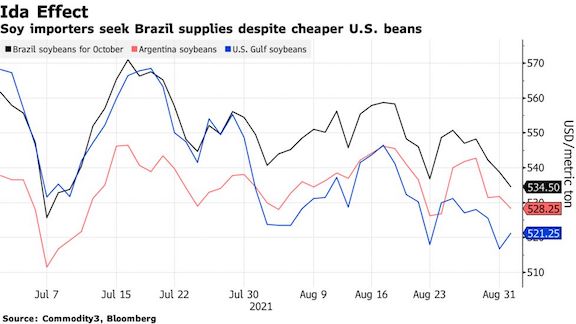Hurricane Ida’s lingering impacts to the busiest U.S. agricultural port is showing early signs of altering crop-trading routes.
China soybean buyers began shifting orders to agricultural powerhouse Brazil for a shipment in October—during the U.S. harvest when American supplies are the biggest—after Ida damaged a key export terminal and left others without power.

“Buyers haven’t had many options to get soybeans after Ida,” said Eduardo Vanin, an analyst at brokerage Agrinvest Commodities, who’s aware of one confirmed cargo of Brazil’s costlier oilseeds. Vanin’s firm is getting more offers for Brazilian soybeans and while not sufficient to attract sellers yet, he said in an interview that they may rise if U.S. port issues linger.
The lower Mississippi river is by far the largest U.S. export region for soybeans and corn, accounting for more than half of U.S. shipments, according to the Soy Transportation Coalition. The shutdown of port facilities that are key to getting American exports overseas are forcing big buyers such as China to look elsewhere and adding to supply-chain snarls that have disrupted shipments for goods ranging from crops to computer chips.
With U.S. Gulf port terminals without power and a large facility operated by Cargill Inc. damaged, traders are expected to boost rail shipments to the Pacific Northwest to sail to Asian markets such as China. Still, outages caused by Ida threaten to hit demand for American supplies just as rainfall lifts yield prospects for corn and soybean fields. Together, rains in the U.S. Midwest and Ida storm damage have pressured crop futures in Chicago.
Meanwhile, Brazil is in its off-season with limited volumes of soybeans available and farmers who have been reluctant to sell at current prices, Vanin said. South American beans have traded at 35 cents to 40 cents per bushel higher than U.S. prices, Vanin said.

Follow us on social media: